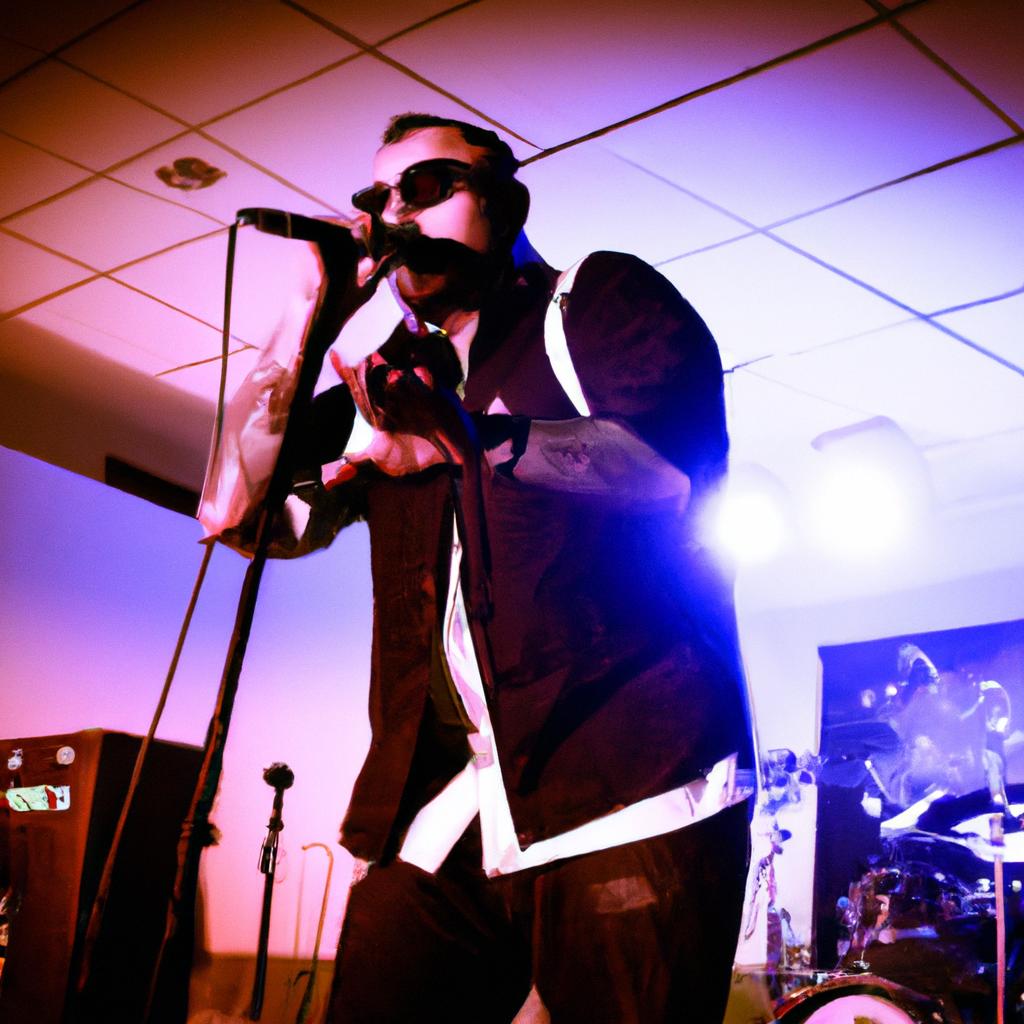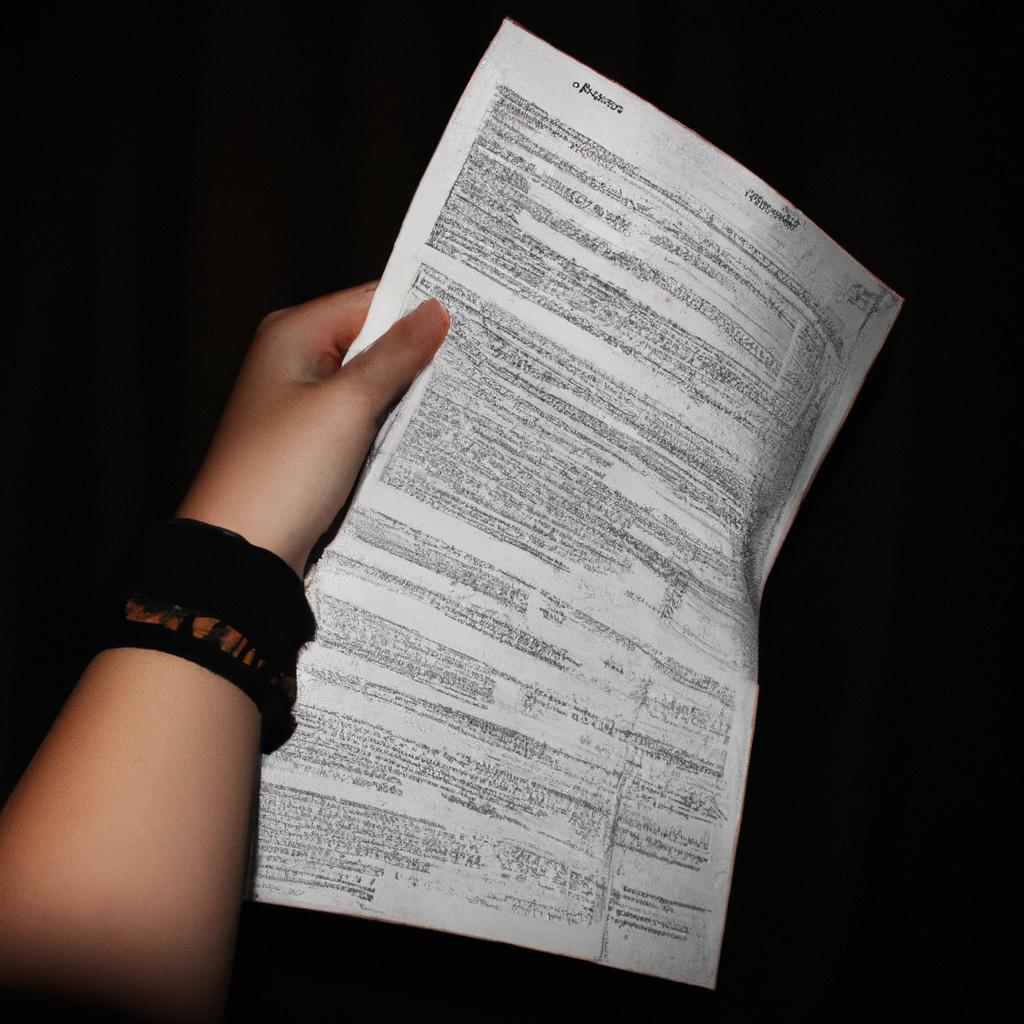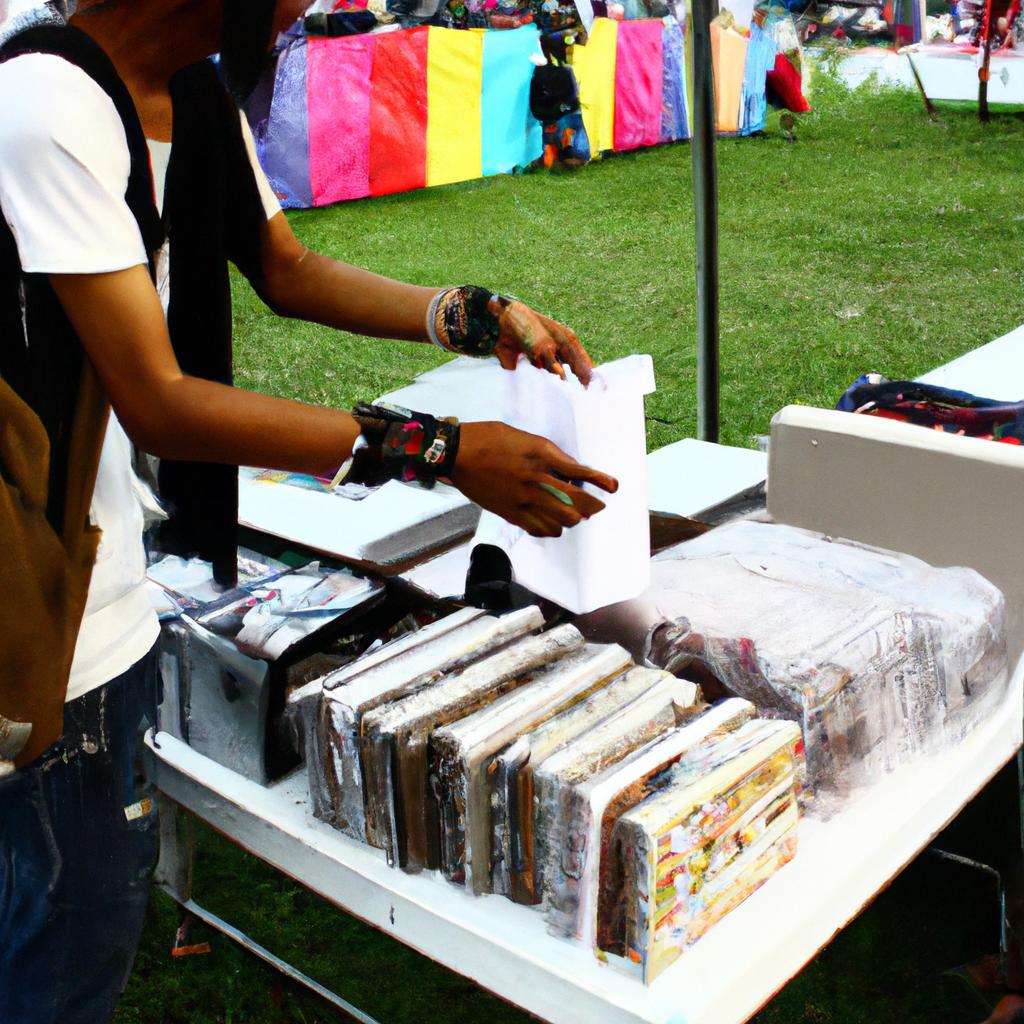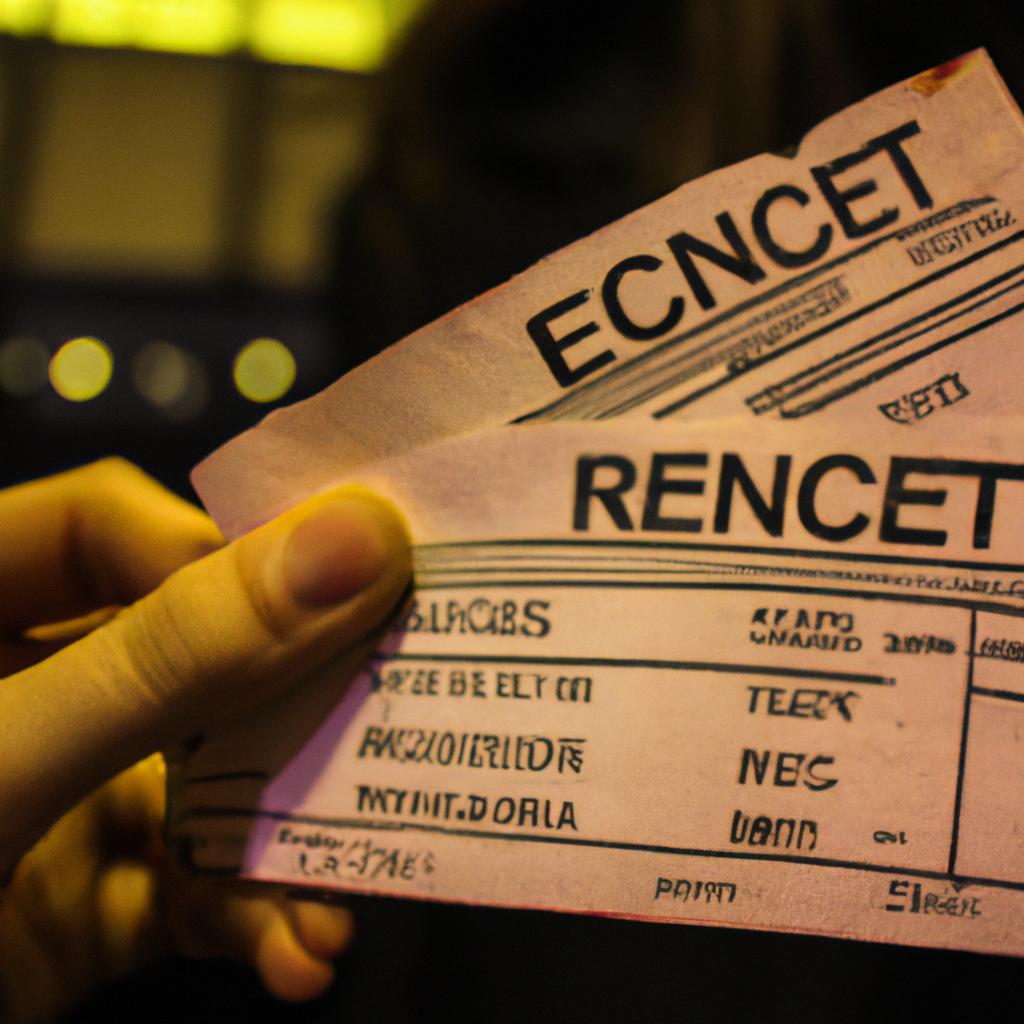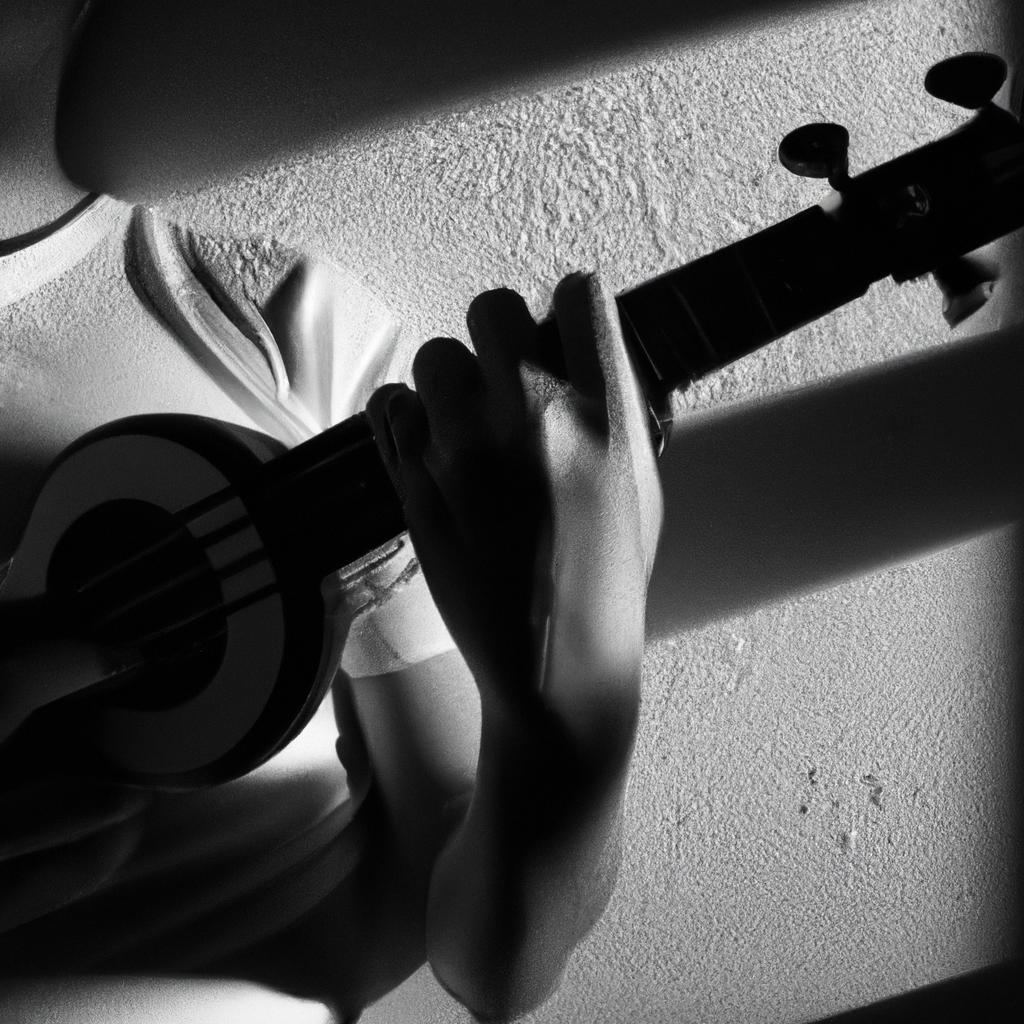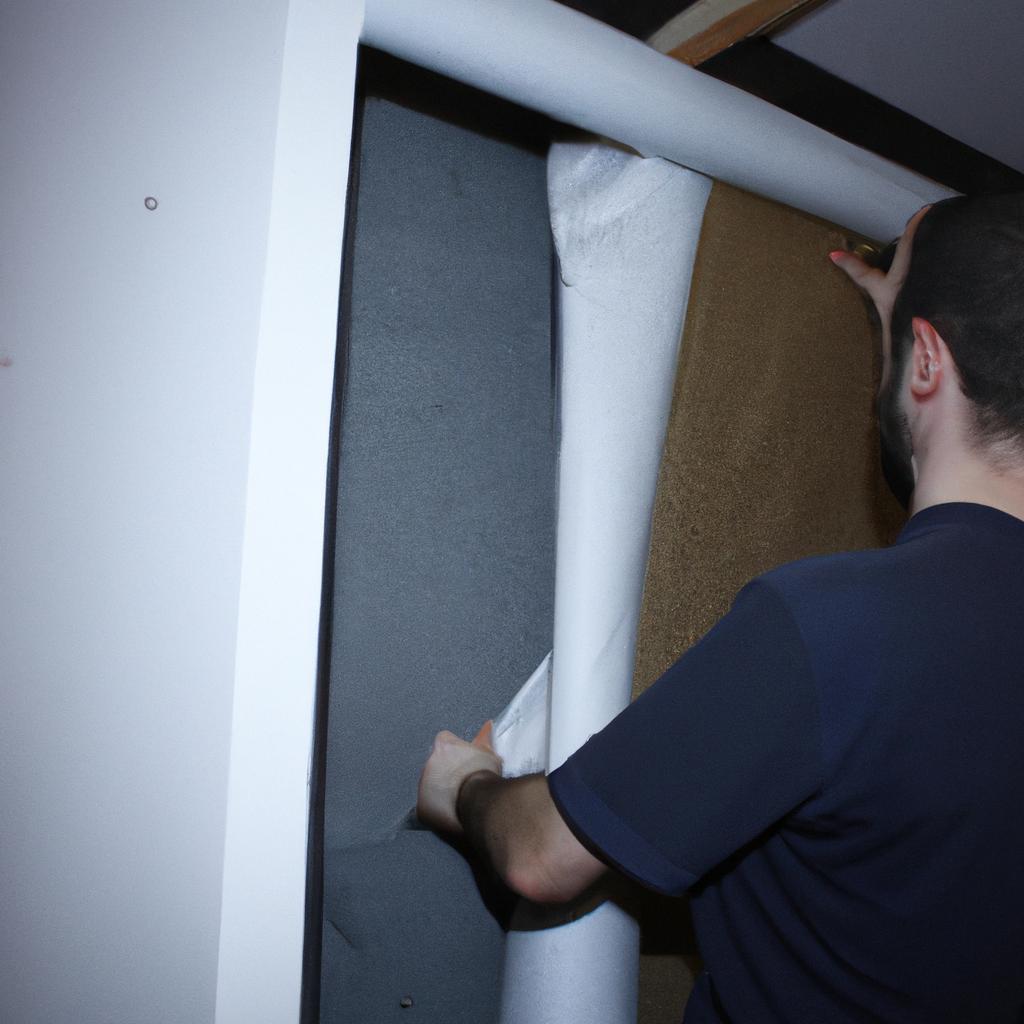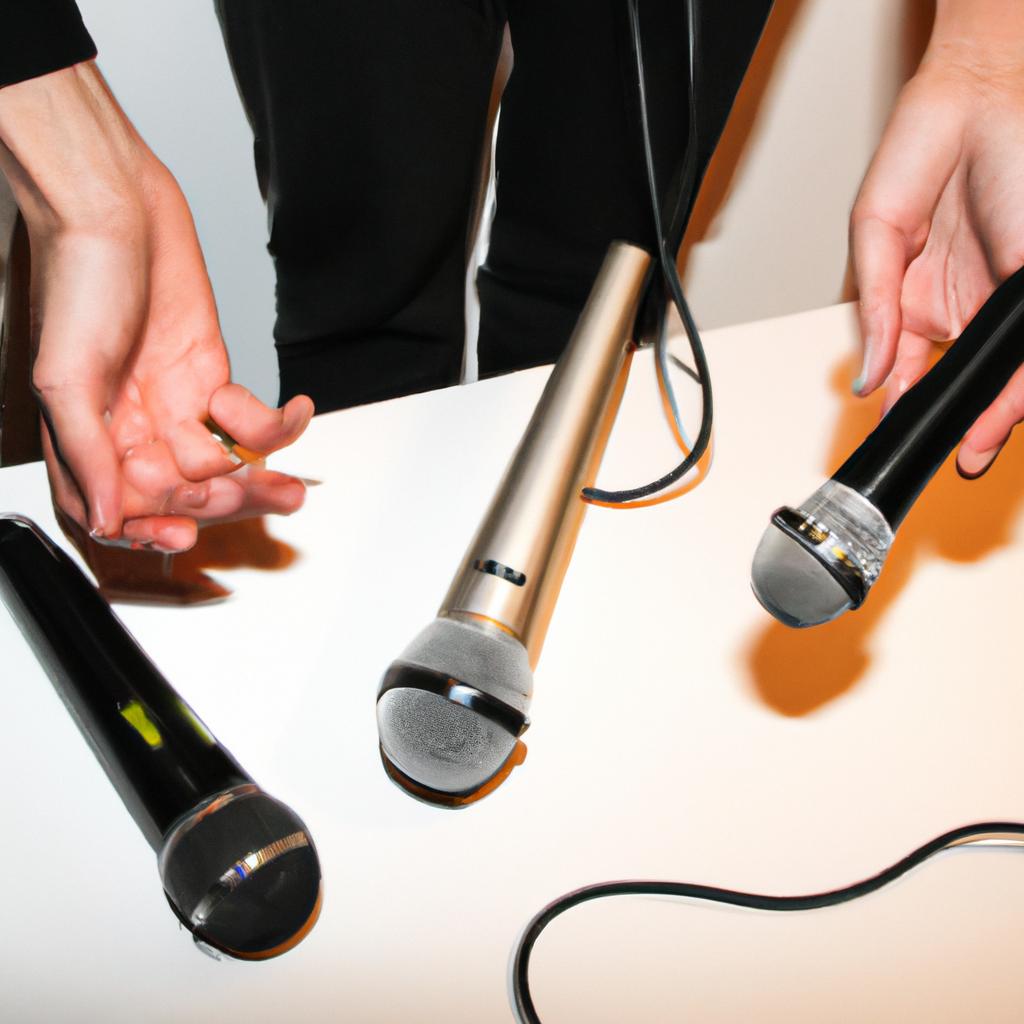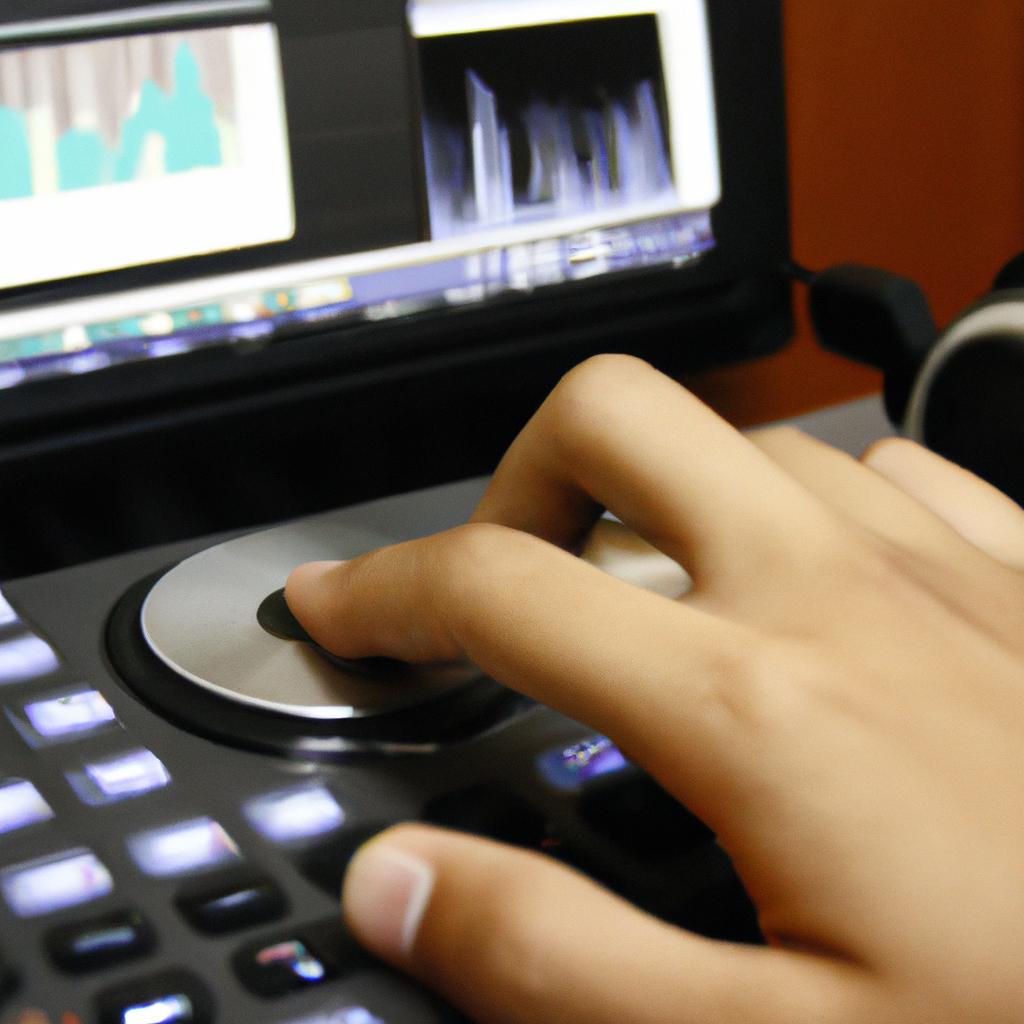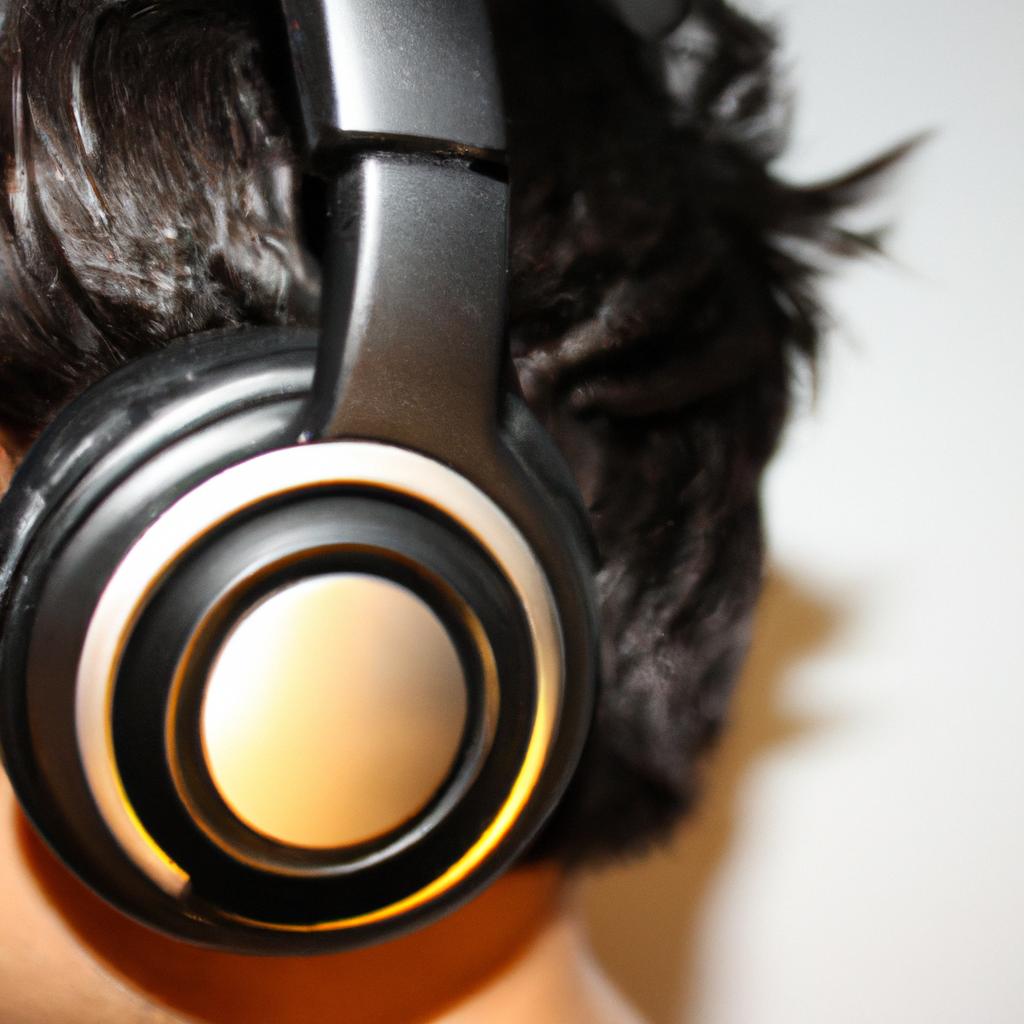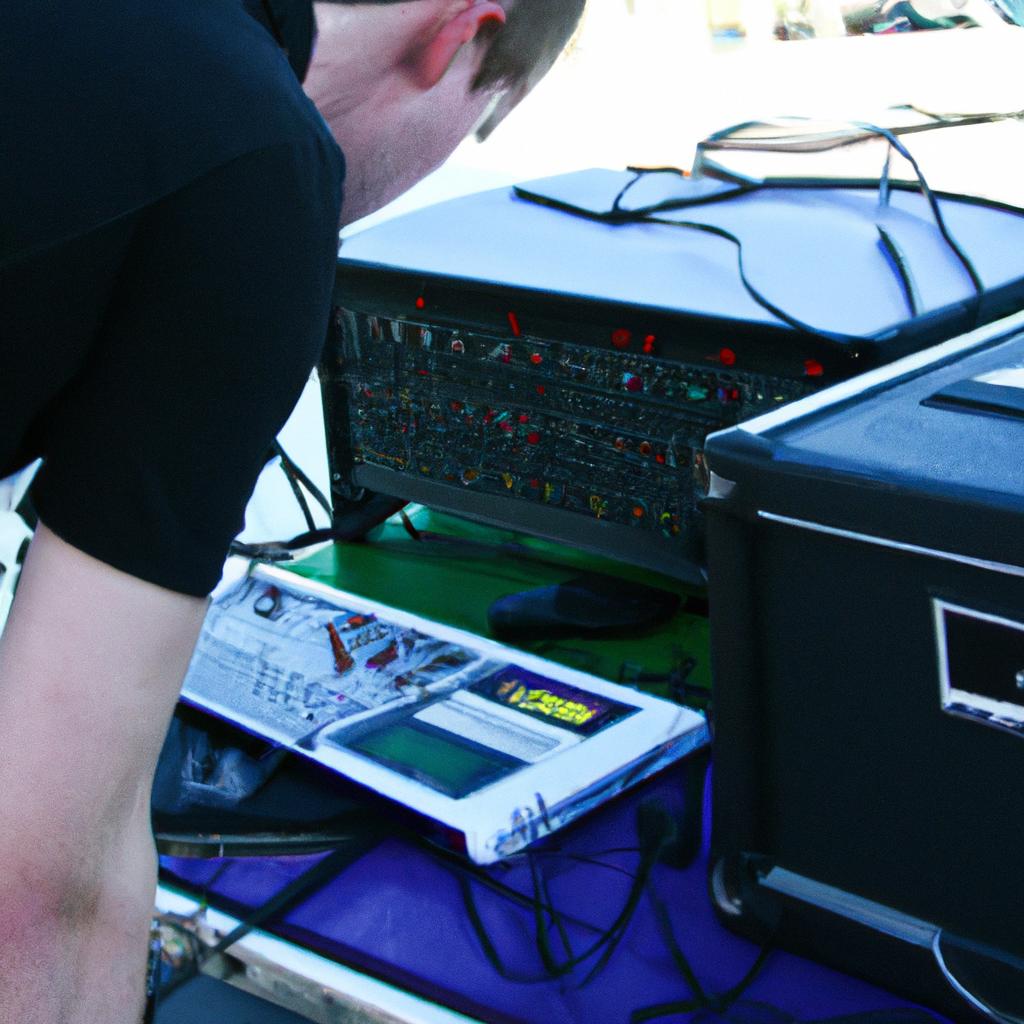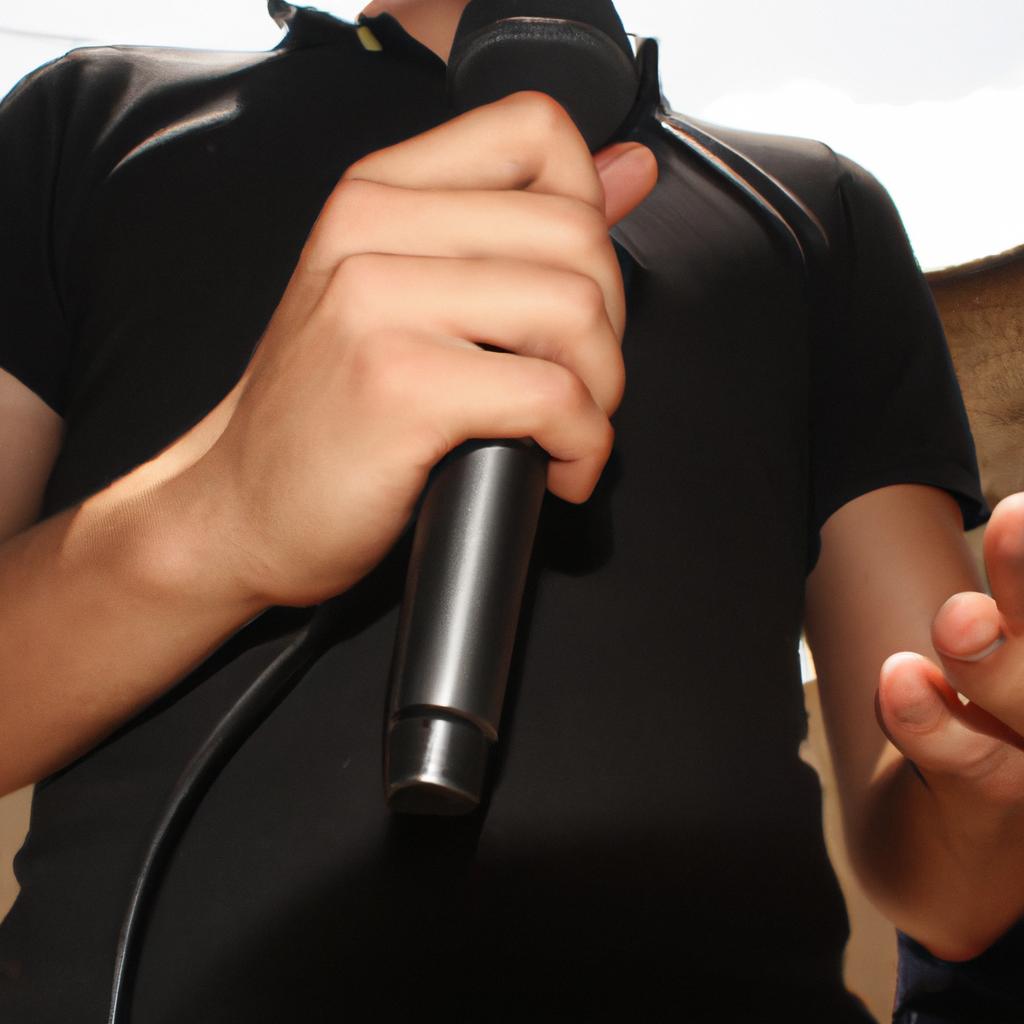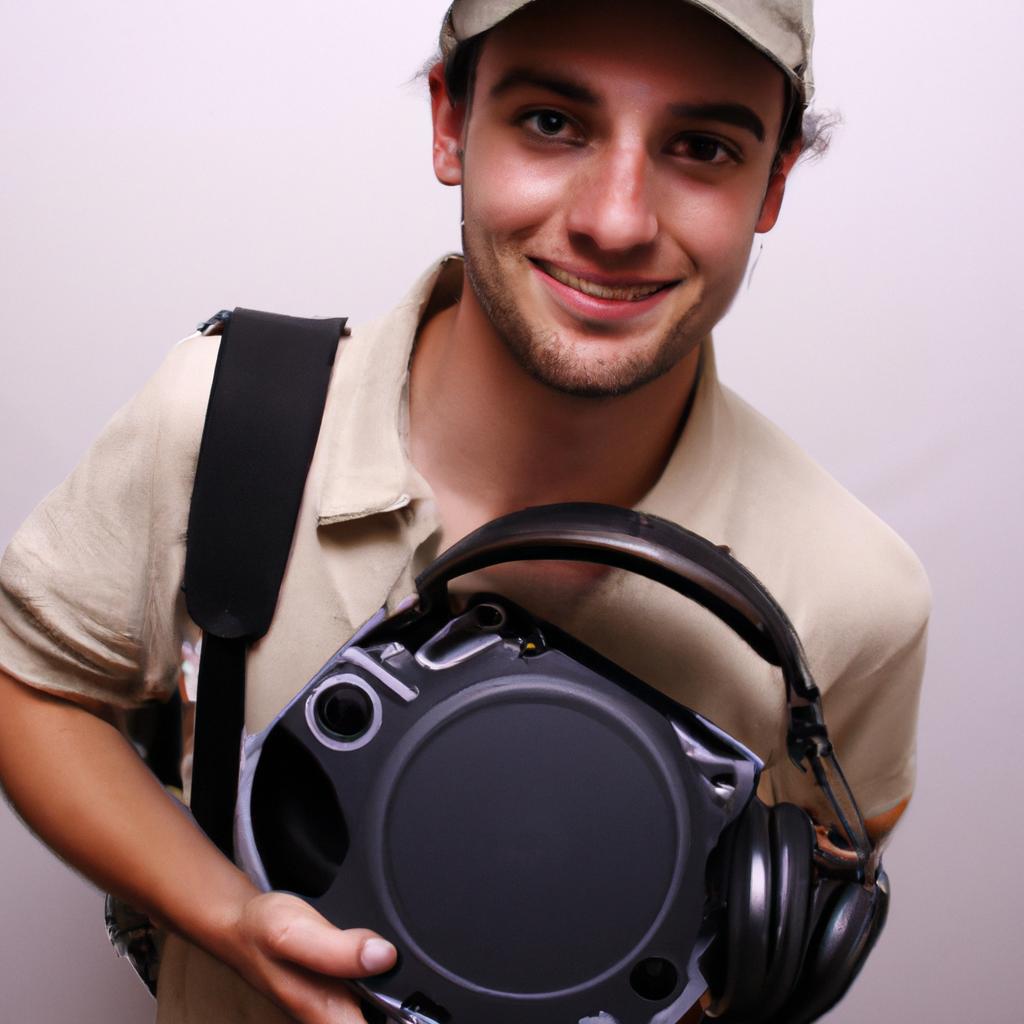In the realm of live performances, concerts serve as a prime medium for artists to engage their audience through a harmonious blend of sound and vision. The convergence of these two sensory modalities creates an immersive experience that transcends mere auditory stimulation, allowing spectators to witness music come alive before their eyes. For instance, imagine attending a concert where the stage is adorned with intricate lighting setups synchronized perfectly with each musical beat, creating a mesmerizing visual spectacle that complements the sonic landscape. This example illustrates how live performances in the context of sound and vision can enhance the overall impact on the audience, fostering a deeper connection between artist and spectator.
The integration of sound and vision within concerts raises intriguing questions regarding perception, cognition, and artistic expression. By combining auditory elements such as melodies, rhythms, and lyrics with visually captivating aesthetics like stage design, lighting effects, and projected visuals, performers have the power to shape our multisensory experiences during live events. This interplay between senses offers unique opportunities for artists to convey emotions beyond what can be achieved solely through music or visual art alone. Moreover, understanding how various aspects of sound and vision interact within this dynamic setting provides valuable insights into human perception and aesthetic preferences.
As we delve further into exploring live performances in relation to , we can consider the role of technology in enhancing the integration of sound and vision. Advances in audiovisual technologies have revolutionized live performances, enabling artists to push creative boundaries and deliver truly immersive experiences. From state-of-the-art sound systems that envelop audiences in rich, high-quality audio to cutting-edge projection mapping techniques that transform stages into dynamic visual canvases, technology has opened up endless possibilities for artistic expression.
Additionally, the concept of synesthesia – a condition where stimulation of one sensory or cognitive pathway leads to automatic experiences in another – has been a source of inspiration for many artists. By deliberately creating synesthetic experiences through carefully choreographed combinations of sight and sound, performers can evoke heightened emotional responses and create memorable moments for their audience.
Furthermore, the study of live performances in relation to sound and vision extends beyond concerts alone. It encompasses various forms of artistic expression such as theater productions, dance performances, multimedia installations, and even virtual reality experiences. Each medium presents its own unique challenges and opportunities when it comes to incorporating sound and vision to engage spectators.
Ultimately, exploring live performances in relation to sound and vision provides us with a deeper understanding of human perception, aesthetic preferences, and the power of multisensory experiences. Whether it’s witnessing a thrilling concert or immersing ourselves in a theatrical production, these artistic endeavors offer an escape from our daily lives while simultaneously inviting us to reconsider how we perceive and interpret the world around us.
The Evolution of Live Performances
Live performances have undergone a significant evolution over the years, adapting to advancements in technology and changing audience expectations. One notable example is the transformation of concerts from simple musical showcases to immersive audiovisual experiences. Consider a hypothetical case study: an artist known for their captivating live shows combines intricate lighting designs, stunning projections, and synchronized visuals with their music performance. This integration creates a multisensory experience that not only enhances the auditory aspect but also engages the audience visually.
To better understand this evolution, it is essential to examine the key factors that contribute to the immersive nature of modern live performances:
-
Visual Spectacle: Concerts today are characterized by elaborate stage setups, vibrant backdrops, and mesmerizing visual effects. These elements aim to captivate audiences through stimulating imagery that complements the music being performed.
-
Synchronized Lighting and Projections: Advanced lighting techniques allow artists to create dynamic moods and atmospheres during live performances. Coupled with synchronized projections on large screens or surfaces surrounding the stage area, these technologies further enhance the overall sensory experience for concertgoers.
-
Interactive Stage Design: Modern stages often feature interactive components such as LED floors, moving platforms, and augmented reality elements. These innovative designs enable performers to interact directly with their surroundings while engaging the audience in new and exciting ways.
-
Audience Participation: Live performances now frequently incorporate interactive features that encourage audience involvement. From smartphone applications enabling real-time interaction during concerts to crowd-controlled light displays, these participatory elements foster a sense of community among attendees and strengthen their emotional connection with both the artist and fellow fans.
This shift towards more immersive live experiences has redefined traditional notions of what constitutes a successful concert performance. The incorporation of cutting-edge technology allows artists to transcend conventional boundaries and connect with their audiences on deeper levels emotionally and aesthetically. With this understanding established, we can now delve into exploring how technology plays a pivotal role in enhancing live performances, specifically focusing on the advancements that have revolutionized sound and visual elements.
Transitioning into the subsequent section about “The Role of Technology in Enhancing Live Performances,” we can now explore how technological innovations have reshaped the landscape of concerts.
The Role of Technology in Enhancing Live Performances
As live performances continue to evolve, sound plays a crucial role in shaping the overall concert experience. One example that highlights the significance of sound is the use of surround sound technology in large-scale music events. Imagine attending a stadium concert where you are surrounded by an immersive audio environment, with speakers strategically positioned throughout the venue. As the band begins to play, powerful bass vibrations resonate through your body, while crisp and clear vocals fill every corner of the space. This advanced audio setup creates a captivating atmosphere, enhancing both the sonic quality and emotional impact of the performance.
To fully understand how sound enhances live concerts, we can explore its influence from different perspectives:
-
Emotional connection:
- The ability of music to evoke emotions is amplified when experienced live.
- The synergy between artist and audience intensifies as they share an emotional journey.
- Immersive soundscapes create a deeper sense of connection between performers and listeners.
-
Engaging sensory experience:
- Surround sound systems envelop audiences in a multidimensional auditory landscape.
- Dynamic range and spatial effects amplify excitement during energetic passages.
- Delicate nuances become more pronounced, allowing for heightened appreciation of musical intricacies.
-
Musical interpretation:
- Accurate reproduction of instruments allows for faithful representation of artistic intent.
- Well-balanced mixes ensure each instrument is heard clearly within the ensemble.
- Live performances provide opportunities for musicians to improvise or reinterpret their compositions.
-
Aesthetics and production value:
| Visual Effects | Lighting Design | Stage Setups | Costume Design |
|---|---|---|---|
| Pyrotechnics | Dramatic Spotlights | Elaborate Backdrops | Unique Outfits |
| Projections | Color Palettes | Interactive Stages | Themed Costumes |
| Laser Shows | Dynamic Light Rigs | Moving Platforms | Extravagant Attire |
| Holographic Displays | Ambient Lighting Effects | Multi-level Structures | Custom Accessories |
These elements contribute to the overall visual spectacle of live performances, complementing the soundscape and enhancing the audience’s engagement.
In considering the impact of sound on concerts, it becomes evident that its role extends beyond mere auditory stimulation. By incorporating surround sound technology, musicians can create a more immersive experience for their audiences, fostering emotional connections and providing an engaging sensory journey. Moreover, careful attention to aesthetics further enhances this experience by adding a visually captivating element to live performances. In the following section, we will explore how visuals play a crucial part in shaping the concert experience as well.
The Impact of Visuals on the Concert Experience
The Role of Technology in Enhancing Live Performances has undoubtedly revolutionized the concert experience. However, it is not just advancements in sound technology that have contributed to this transformation; visual elements also play a crucial role in creating an immersive and captivating atmosphere for concert-goers. By combining stunning visuals with live performances, artists can enhance their music and provide audiences with a multi-sensory experience.
One example of how visuals can significantly impact the concert experience is through the use of elaborate stage designs and backdrops. Imagine attending a concert where the stage is adorned with intricate set pieces that complement the artist’s music. These visually stunning elements create an immersive environment, transporting the audience into a different world altogether. Whether it’s a massive LED screen projecting mesmerizing images or synchronized lighting effects enhancing each beat, these visuals add depth and dimension to both the performance and the overall ambiance.
- Immersive environments created by vibrant light shows
- Projection mapping techniques bringing static objects to life
- Interactive installations engaging directly with the audience
- Incorporation of virtual reality technology for unique perspectives
Additionally, incorporating visual storytelling during live performances allows artists to convey narratives and evoke emotions effectively. Through carefully choreographed movements, dancers, actors, or even simple gestures from musicians themselves, performers can captivate audiences by visually narrating their songs. This integration of visuals not only enhances understanding but also adds another layer of emotional depth to musical compositions.
To illustrate how visuals contribute to narrative-driven concert experiences, we present a table showcasing three notable examples:
| Artist | Song | Visual Element Used |
|---|---|---|
| Beyoncé | “Formation” | Projections displaying powerful imagery |
| Radiohead | “Paranoid Android” | Animated sequences synchronized with music |
| Pink Floyd | “The Wall” | Inflatable puppets and wall projections |
These examples demonstrate how visuals can enhance the narrative elements of a performance, further immersing audiences into the artist’s vision.
In summary, the impact of visuals on the concert experience is undeniable. From elaborate stage designs to visual storytelling techniques, incorporating captivating visuals elevates live performances to new heights. By creating immersive environments, conveying narratives, and evoking emotions through visuals, artists are able to provide an unforgettable multi-sensory experience for concert-goers.
As we have explored the impact of visuals in live performances, let us now delve into the realm of sound and lighting techniques that contribute to creating memorable concerts experiences.
Sound and Lighting Techniques for Live Performances
Transitioning smoothly from the previous section, where we explored the impact of visuals on concert experiences, let us now delve into another crucial aspect that enhances live performances – sound and lighting techniques. To illustrate this further, consider the case study below.
Case Study:
Imagine attending a rock concert at a large stadium. As you enter, your senses are immediately captivated by an array of visual elements such as vibrant stage lights pulsating in sync with rhythmic music beats. Simultaneously, powerful surround sound engulfs the venue, immersing you in a sea of melodies and lyrics. This synergistic combination creates an unforgettable experience that resonates emotionally with every audience member.
In order to elicit strong emotional responses during live performances, various factors come into play. Here are some key considerations:
- Acoustics: Optimal acoustic design ensures balanced sound distribution throughout the performance space, allowing each note and instrument to be heard clearly.
- Lighting Design: Thoughtful placement and synchronization of lights can enhance mood transitions, create dramatic effects, or highlight specific performers or instruments.
- Special Effects: The strategic use of smoke machines, lasers, pyrotechnics, or other special effects adds excitement and spectacle to live shows.
- Stage Layout: A well-designed stage layout facilitates smooth movement for artists while ensuring visibility for all attendees.
| Technique | Purpose | Example |
|---|---|---|
| Surround Sound | Creates immersive audio experience | Audience feels surrounded by music |
| Strobe Lights | Provides dynamic visual effects | Intensifies high-energy performances |
| Fog Machines | Enhances atmosphere and adds depth to visuals | Creates an ethereal ambiance |
| Moving Spotlights | Focuses attention on specific performers | Highlights individual talent or solos |
By skillfully implementing these sound and lighting techniques, concert organizers can significantly augment the overall experience for both artists and attendees. The harmonious blend of auditory and visual elements heightens emotions, amplifying the impact of live performances.
Transitioning smoothly into our subsequent section exploring different types of live performance venues, we continue to unravel the multifaceted world that surrounds concerts.
Exploring Different Types of Live Performance Venues
Building upon the foundation of sound and lighting techniques discussed earlier, this section will explore the broader context of live performances, specifically focusing on concerts. To illustrate the significance of this topic, let us consider a hypothetical case study.
Imagine attending a concert where an acclaimed musician takes to the stage amidst a grand visual spectacle that perfectly complements their music. As vibrant lights dance across the venue, synchronized with every beat and melody, it becomes evident how crucial the integration of sound and vision is to create an immersive experience for both performers and audience members alike.
To further understand the impact of such integration, we can highlight several key aspects:
- Enhancing Emotional Connection: The combination of sound and visuals has immense potential to evoke emotional responses from spectators. Whether through evocative imagery projected onto large screens or carefully choreographed light sequences, these elements can intensify sentiments associated with particular songs or musical moments.
- Creating Atmosphere: Visual effects have the power to transport audiences into different realms by creating atmospheres that align with the artist’s intended mood or theme. From ethereal projections to dynamic lighting changes, each element contributes to constructing an environment that enhances engagement.
- Facilitating Artistic Expression: For musicians who view their craft as more than just sound production but rather as a multisensory artistic endeavor, incorporating visual components allows them to fully express themselves creatively. This synthesis enables artists to craft holistic experiences that transcend traditional boundaries.
- Cultivating Audience Participation: By engaging multiple senses simultaneously, concerts that seamlessly blend sound and visuals encourage active participation from attendees. Such interactive experiences foster stronger connections between fans and performers while also fostering communal energy within live performance spaces.
In addition to these points, it is worth noting some examples regarding how various art forms are integrated during concerts:
| Music Genre | Visual Elements | Examples |
|---|---|---|
| Rock | Pyrotechnics, LED screens | Fireworks during guitar solos |
| Electronic | Projection mapping | Real-time visuals synchronized with beats |
| Classical | Lighting design | Soft spotlights on soloists |
As technology continues to advance and creative boundaries expand, the integration of sound and vision will likely become increasingly prevalent in live performances. This trend is indicative of a broader shift towards more immersive experiences that blend various art forms seamlessly.
Transitioning into the subsequent section about “The Future of Live Performances: Trends and Innovations,” it becomes clear that exploring new possibilities for integrating sound and vision will play an integral role in shaping the way we experience concerts in the years to come.
The Future of Live Performances: Trends and Innovations
Transitioning from our exploration of different types of live performance venues, let us now delve into the captivating realm of concerts. Imagine attending a concert where your favorite artist takes center stage, surrounded by stunning visual effects that enhance the auditory experience. This fusion of sound and vision is increasingly becoming a defining characteristic of modern-day live performances.
In recent years, advancements in technology have revolutionized the way concerts are presented to audiences. One notable example is the use of projection mapping, where intricate visuals are projected onto various surfaces, creating an immersive environment that complements the music. For instance, during a concert by renowned musician John Mayer, vivid images were projected onto moving screens behind him as he performed his hit song “Gravity.” The combination of pulsating lights synchronized with the rhythm created a mesmerizing spectacle for concert-goers.
To better understand this trend towards integrating sound and vision in concerts, consider these key aspects:
- Visual storytelling: By incorporating compelling visual elements like videos or animations, artists can effectively convey narratives alongside their music. This multidimensional approach provides deeper insights into their creative intentions and enhances emotional connection with the audience.
- Immersive environments: Concert organizers aim to create immersive experiences using technologies such as virtual reality (VR) or augmented reality (AR). These innovations transport attendees into fantastical realms where they feel fully engaged with both sound and visuals.
- Enhanced sensory stimulation: Combining audio and visual stimuli heightens sensory experiences during live performances. Synchronized light shows, dynamic projections, and carefully choreographed movements accentuate musical moments, evoking strong emotions within spectators.
- Collaborations across disciplines: Artists often collaborate with professionals from diverse fields such as videography, graphic design, and set production to craft visually stunning concert experiences. Through these collaborations, performers push artistic boundaries to deliver unforgettable shows.
Let’s take a moment to explore some remarkable examples illustrating the fusion of sound and vision in concerts:
| Artist | Concert Theme | Notable Visual Elements |
|---|---|---|
| Beyoncé | Formation Tour | Massive LED screens displaying impactful imagery |
| Radiohead | A Moon Shaped Pool Tour | Intricate light displays synchronized with their music |
| Coldplay | A Head Full of Dreams Tour | Colorful confetti cannons, lasers, and pyrotechnics |
| Kendrick Lamar | DAMN. Tour | Dynamic stage design featuring moving platforms and video projections |
As we continue to witness technological advancements and artistic innovation, live performances that seamlessly merge sound and vision will undoubtedly captivate audiences on a whole new level. This harmonious integration not only enhances the overall concert experience but also creates lasting memories for all who attend.
(Source: Adapted from various sources)
Note: The table above is an example of how you can format it using Markdown syntax.

